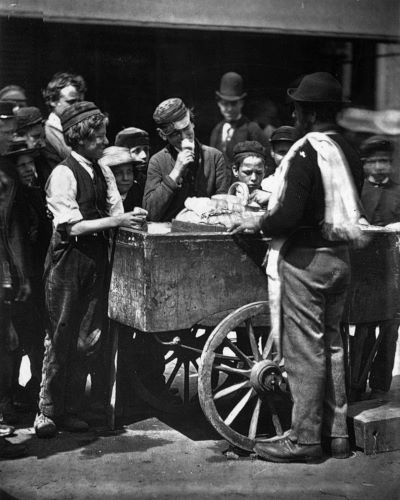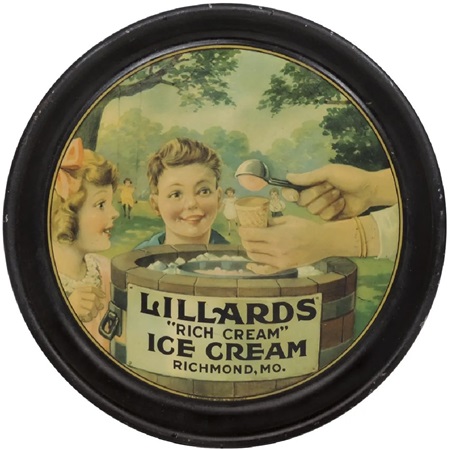The 'Stock' Exchange
American Art Works: No. 153
American Art Works: No. 153
Date: 1925 - 1930
Size: 13.5" x 13.5"
Type: Pie
Scarcity: Rare
Value: $$ to $$$
Condition & Brewer Dependent
Size: 13.5" x 13.5"
Type: Pie
Scarcity: Rare
Value: $$ to $$$
Condition & Brewer Dependent


General Comments
Obviously, another design squarely aimed at ice cream manufacturers since this came out in the midst of prohibition. Although we have never seen copyright information associated with this design, we assume it cannot be any earlier than 1925 (based on the copyright for No. 150) and is likely a year or two later. Why this one is so scarce is a bit of a mystery. Perhaps it was overshadowed by No. 150, which was very popular and must have been in the catalog for several years. No. 156 also appears to have been used by quite a number of ice cream manufacturers.
After six or seven preceding designs oriented toward ice cream spanning at least seventeen years, this design finally introduces the ice cream cone. In a previous discussion related to one of the earlier ice cream designs, we made reference to the supposed origin story of the ice cream cone at the 1904 World’s Fair in St. Louis. The apocryphal story (which now sounds like slick marketing to us) says that Ernest A. Hamwi, a Syrian concessionaire was selling a crisp, waffle-like pastry -- zalabis -- in a booth right next to an ice cream vendor. Because of ice cream's popularity, the vendor ran out of dishes. Hamwi saw an easy solution to the ice cream vendor's problem: he quickly rolled one of his wafer-like waffles in the shape of a cone, or cornucopia, and gave it to the ice cream vendor. The cone cooled in a few seconds, the vendor put some ice cream in it, and the customers were happy. And thus, the ice cream cone was born.
In reality, according to the International Dairy Federation of America, the first ice cream cone was produced in 1896 by Italo Marchiony who emigrated from Italy in the late 1800s and invented his ice cream cone in New York City. He was granted a patent in December 1903. The impetus was due to the need for improved sanitation related to ice cream street vendors. Prior to the invention of the cone, vendors would serve portions of ice cream in glasses (a special cone-shaped glass called a “penny lick”) that would then be reused by the next customer without washing, potentially spreading disease.
Obviously, another design squarely aimed at ice cream manufacturers since this came out in the midst of prohibition. Although we have never seen copyright information associated with this design, we assume it cannot be any earlier than 1925 (based on the copyright for No. 150) and is likely a year or two later. Why this one is so scarce is a bit of a mystery. Perhaps it was overshadowed by No. 150, which was very popular and must have been in the catalog for several years. No. 156 also appears to have been used by quite a number of ice cream manufacturers.
After six or seven preceding designs oriented toward ice cream spanning at least seventeen years, this design finally introduces the ice cream cone. In a previous discussion related to one of the earlier ice cream designs, we made reference to the supposed origin story of the ice cream cone at the 1904 World’s Fair in St. Louis. The apocryphal story (which now sounds like slick marketing to us) says that Ernest A. Hamwi, a Syrian concessionaire was selling a crisp, waffle-like pastry -- zalabis -- in a booth right next to an ice cream vendor. Because of ice cream's popularity, the vendor ran out of dishes. Hamwi saw an easy solution to the ice cream vendor's problem: he quickly rolled one of his wafer-like waffles in the shape of a cone, or cornucopia, and gave it to the ice cream vendor. The cone cooled in a few seconds, the vendor put some ice cream in it, and the customers were happy. And thus, the ice cream cone was born.
In reality, according to the International Dairy Federation of America, the first ice cream cone was produced in 1896 by Italo Marchiony who emigrated from Italy in the late 1800s and invented his ice cream cone in New York City. He was granted a patent in December 1903. The impetus was due to the need for improved sanitation related to ice cream street vendors. Prior to the invention of the cone, vendors would serve portions of ice cream in glasses (a special cone-shaped glass called a “penny lick”) that would then be reused by the next customer without washing, potentially spreading disease.

In 1885, the Cincinnati Enquirer chronicled the appearance of this "novel luxury." "Just the thing for picnics," the reporter declared. "No spoons nor saucers needed, no washing of dishes." The emphasis here lends credence to the idea that the hokey-pokey's paper wrapper represented growing interest in single-use vessels and the resulting ease of cleanup. Eventually Marchiony improved on the hokey-pokey with the edible cone.
The pink ice cream being served would likely have been strawberry, as fruit flavors were popular at this time, along with chocolate and vanilla. Strawberry was one of the first ice cream flavors ever created, and was first served in 1744 when Maryland Governor Thomas Bladen would serve it to visiting guests. During James Madison’s second inauguration in 1813, First Lady Dolley Madison served a “magnificent” strawberry ice cream that popularized the flavor. This went on to become one of the three flavors found in Neapolitan ice cream along with vanilla and chocolate. This pink flavor has actually grown with such fervor that every year on January 15, Americans celebrate National Strawberry Ice Cream Day.
Sahling's Design Notes
By this time Sahling had left the Art Department and there are no further entries in his workbook.
Size, Shape and Message Placement
The few times we’ve seen this design have all been concave pie shapes, with black rims and gold advertising text on the rim. Advertising text also appears on the front of the ice cream tub, usually black text on a gold field. The gold field on the front of the tub is part of the design and was intended to feature advertising text, based on its appearance on a stock sample.
Hager & Price
Hager does not have any designs beyond “When Dreams Come True”; (No. 150) in his catalog; in this case it does not surprise us because either he never encountered it because it’s so scarce or he did not recognize it as a stock design. Despite the scarcity this tray, it does not seem to command much interest from collectors, only garnering low double figures for the few examples we have observed. Admittedly condition ranged from below average, to slightly above average, so it would be interesting to see what a very good or excellent one would bring.
The pink ice cream being served would likely have been strawberry, as fruit flavors were popular at this time, along with chocolate and vanilla. Strawberry was one of the first ice cream flavors ever created, and was first served in 1744 when Maryland Governor Thomas Bladen would serve it to visiting guests. During James Madison’s second inauguration in 1813, First Lady Dolley Madison served a “magnificent” strawberry ice cream that popularized the flavor. This went on to become one of the three flavors found in Neapolitan ice cream along with vanilla and chocolate. This pink flavor has actually grown with such fervor that every year on January 15, Americans celebrate National Strawberry Ice Cream Day.
Sahling's Design Notes
By this time Sahling had left the Art Department and there are no further entries in his workbook.
Size, Shape and Message Placement
The few times we’ve seen this design have all been concave pie shapes, with black rims and gold advertising text on the rim. Advertising text also appears on the front of the ice cream tub, usually black text on a gold field. The gold field on the front of the tub is part of the design and was intended to feature advertising text, based on its appearance on a stock sample.
Hager & Price
Hager does not have any designs beyond “When Dreams Come True”; (No. 150) in his catalog; in this case it does not surprise us because either he never encountered it because it’s so scarce or he did not recognize it as a stock design. Despite the scarcity this tray, it does not seem to command much interest from collectors, only garnering low double figures for the few examples we have observed. Admittedly condition ranged from below average, to slightly above average, so it would be interesting to see what a very good or excellent one would bring.
Confirmed Brewer used Stock Trays
Non-Beer Related & Non-Tray Uses
Click the Picture to Return to Meek & Beach Stock Catalog Page





